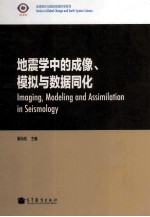

地震学中的成像、模拟与数据同化 英文版PDF电子书下载
- 电子书积分:11 积分如何计算积分?
- 作 者:郦永刚主编
- 出 版 社:北京:高等教育出版社
- 出版年份:2012
- ISBN:9787040343410
- 页数:263 页
Imaging,Modeling and Assimilation in Seismology:An Overview 1
References 11
Chapter 1 Full-Wave Seismic Data Assimilation:A Unified MethodologyforSeismicWaveformInversion 19
1.1 Introduction 19
1.2 Generalized Inverse 21
1.2.1 Prior Probability Densities 22
1.2.2 Bayes'Theorem 25
1.2.3 Euler-Lagrange Equations 26
1.3 Data Functionals 31
1.3.1 Differential Waveforms 32
1.3.2 Cross-correlation Measurements 33
1.3.3 Generalized Seismological Data Functionals (GSDF) 34
1.4 The Adjoint Method 38
1.4.1 An Example of Adjoint Travel-Time Tomography 39
1.4.2 Review of Some Recent Adjoint Waveform Tomography 41
1.5 The Scattering-Integral(SI)Method 42
1.5.1 Full-Wave Tomography Based on SI 44
1.5.2 Earthquake Source Parameter Inversion Based on SI 46
1.6 Discussion 54
1.6.1 Computational Challenges 55
1.6.2 Nonlinearity 57
1.7 Summary 58
References 59
Chapter 2 One-Return Propagators and the Applications in Modeling and Imaging 65
2.1 Introduction 66
2.2 Primary-Only Modeling and One-Return Approximation 67
2.3 Elastic One-Return Modeling 72
2.3.1 Local Born Approximation 73
2.3.2 The Thin Slab Approximation 75
2.3.3 Small-Angle Approximation and the Screen Propagator 77
2.3.4 Numerical Implementation 80
2.3.5 Elastic,Acoustic and Scalar Cases 81
2.4 Applications of One-Return Propagators in Modeling,Imaging and Inversion 81
2.4.1 Applications to Modeling 81
2.4.2 One-Return Propagators Used in Migration Imaging 85
2.4.3 Calculate Finite-Frequency Sensitivity Kernels Used in Velocity Inversion 88
2.5 Other Development of One-Return Modeling 93
2.5.1 Super-Wide Angle One-Way Propagator 93
2.5.2 One-Way Boundary Element Method 95
2.6 Conclusion 99
References 100
Chapter 3 Fault-Zone Trapped Waves:High-Resolution Characterization of the Damage Zone of the Parkfield San Andreas Fault at Depth 107
3.1 Introduction 107
3.2 Fault-Zone Trapped Waves at the SAFOD Site 109
3.2.1 The SAFOD Surface Array 111
3.2.2 The SAFOD Borehole Seismographs 116
3.2.3 Finite-Difference Simulation of Fault-Zone Trapped Waves at SAFOD Site 124
3.3 Fault-Zone Trapped Waves at the Surface Array near Parkfield Town 132
3.4 Conclusion and Discussion 135
Acknowledgements 138
References 138
Appendix:Modeling Fault-Zone Trapped SH-Love Waves 143
Chapter 4 Fault-Zone Trapped Waves at a Dip Fault:Documentation of Rock Damage on the Thrusting Longmen-Shan Fault Rupturedinthe 2008 M8 WenchuanEarthquake 151
4.1 Geological Setting and Scientific Significance 152
4.2 Data and Results 154
4.2.1 Data Collection 154
4.2.2 Examples of Waveform Data 157
4.3 3-D Finite-Difference Investigations of Trapping Efficiency at the Dipping Fault 164
4.3.1 Effect of Fault-Zone Dip Angle 166
4.3.2 Effect of Epicentral Distance 169
4.3.3 Effect of Source Depth 171
4.3.4 Effect of Source away from Vertical and Dip Fault Zones 172
4.3.5 Effect of Fault-Zone Width and Velocity Reduction 175
4.4 3-D Finite-Difference Simulations of FZTWs at the South Longmen-Shan Fault 175
4.5 Fault Rock Co-Seismic Damage and Post-Mainshock Heal 180
4.6 Conclusion and Discussion 186
Acknowledgements 190
References 190
Appendix 196
Chapter 5 Ground-Motion Simulations with Dynamic Source CharacterizationandParallelComputing 199
5.1 Introduction 199
5.2 The Spontaneous Rupture Model 200
5.3 EQdyna:An Explicit Finite Element Method for Simulating Spontaneous Rupture on Geometrically Complex Faults and Wave Propagation in Complex Geologic Structure 203
5.4 Two Examples of Ground-Motion Related Applications of EQdyna 206
5.4.1 Sensitivity of Physical Limits on Ground Motion on Yucca Mountain 206
5.4.2 Effects of Faulting Style Changes on Ground Motion 209
5.5 Hybrid MPI/OpenMP Parallelization of EQdyna and Its Application to a Benchmark Problem 210
5.5.1 Element-size Dependence of Solutions 211
5.5.2 Computational Resource Requirements and Performance Analysis 215
5.6 Conclusions 215
Acknowledgements 216
References 216
Chapter 6 Load-Unload Response Ratio and Its New Progress 219
6.1 Introduction 219
6.2 The Status of Earthquake Prediction Using LURR 223
6.3 Peak Point ofthe LURR and Its Significance 224
6.4 Earthquake Cases in 2008-2009 226
6.5 Improving the Prediction of Magnitude M and T2-Application of Dimensional Method 227
6.5.1 Location 227
6.5.2 Magnitude 227
6.5.3 Occurrence time(T2) 231
6.6 Conclusions 232
Acknowledgements 232
References 232
Chapter 7 Discrete Element Method and Its Applications inEarthquake and Rock Fracture Modeling 235
7.1 Introduction 235
7.2 A BriefIntroduction to the Esys_Particle 237
7.3 Theoretical and Algorithm Development 238
7.3.1 The Equations of Particle Motion 238
7.3.2 Contact Laws,Particle Interactions and Calculation of Forces and Torques 239
7.3.3 Calibration of the Model 242
7.3.4 Incorporation of Thermal and Hydrodynamic Effects 243
7.3.5 Parallel Algorithm 245
7.4 Some Numerical Results Obtained by Using the Esys_Particle 245
7.4.1 Earthquakes 245
7.4.2 Rock fracture 251
7.5 Coupling of Multiple Physics 254
7.5.1 Thermal-Mechanical Coupling 254
7.5.2 Hydro-Mechanical Coupling 255
7.5.3 Full Solid-Fluid Coupling 255
7.6 Discussion and Conclusions 256
Acknowledgements 258
References 258
- 《卓有成效的管理者 中英文双语版》(美)彼得·德鲁克许是祥译;那国毅审校 2019
- 《地采暖用实木地板》张凯,黄安民 2019
- 《舰载逆合成孔径雷达成像》孙思博著 2019
- 《AutoCAD 2018自学视频教程 标准版 中文版》CAD/CAM/CAE技术联盟 2019
- 《彩叶地被植物》(中国)杭州市临安区科学技术协会,杭州市临安区林业局(农业局) 2018
- 《跟孩子一起看图学英文》张紫颖著 2019
- 《AutoCAD机械设计实例精解 2019中文版》北京兆迪科技有限公司编著 2019
- 《宅基地“三权分置”中农民分享退地增值收益研究》王兆林 2019
- 《复分析 英文版》(中国)李娜,马立新 2019
- 《张世祥小提琴启蒙教程 中英文双语版》张世祥编著 2017
- 《全国高等中医药行业“十三五”创新教材 中医药学概论》翟华强 2019
- 《培智学校义务教育实验教科书教师教学用书 生活适应 二年级 上》人民教育出版社,课程教材研究所,特殊教育课程教材研究中心编著 2019
- 《指向核心素养 北京十一学校名师教学设计 英语 七年级 上 配人教版》周志英总主编 2019
- 《习近平总书记教育重要论述讲义》本书编写组 2020
- 《办好人民满意的教育 全国教育满意度调查报告》(中国)中国教育科学研究院 2019
- 《高等数学试题与详解》西安电子科技大学高等数学教学团队 2019
- 《北京生态环境保护》《北京环境保护丛书》编委会编著 2018
- 《教育学考研应试宝典》徐影主编 2019
- 《语文教育教学实践探索》陈德收 2018
- 《家庭音乐素养教育》刘畅 2018
